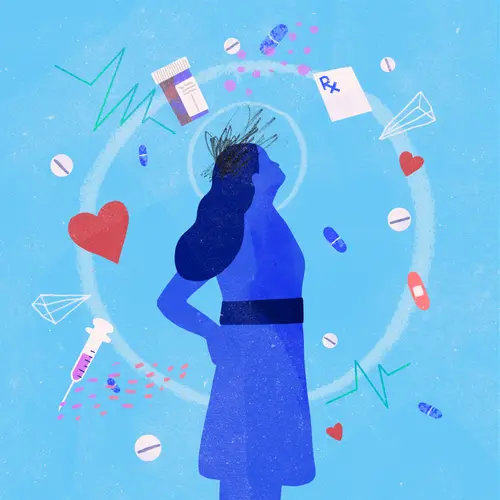Chances are that you may be heard of the term "blue balls" — the uncomfortable sensation occurring in the male genitals due to sexual frustration. Studies show that something similar occurs in those with female genitals. This female equivalent of blue balls is known as "blue vulva" syndrome. Despite being lesser known, this condition is quite common and easy to treat with only a few simple steps.
What Is Blue Vulva Syndrome?
When someone says that they have blue balls, they are referring to the medical condition called epididymal hypertension (EH). This condition occurs when those with male genitals stay aroused for a considerable period of time but are unable to orgasm or ejaculate. Due to this, they feel pain and discomfort in their genitals. Moreover, as the oxygen-deprived blood stays trapped in the testis, it develops a light bluish hue — hence the name blue balls.
While the clitoris — the key pleasure center of the vulva in females — doesn't change color, it's equally prone to feeling discomfort when excess blood remains in it for a long time without release. In slang terms, this aching feeling in the female genitals is known as blue vulva. In some circles, you may also find this condition being called pink pelvis, blue uterus, or blue bean. Here, the bean refers to the clitoris.
While many are familiar with the concept of blue balls, very few know about blue vulva syndrome. There's also not much research done on this topic. This is why there's very little awareness about this condition among the female population.
Why Does Blue Vulva Syndrome Occur?
Blue vulva syndrome is caused by the same factors that lead to blue balls.
When those with male genitals are sexually aroused, the arteries in the sex organs expand so as to supply more blood to the penis. However, the veins carrying the blood away constrict so that extra blood remains within the genitalia. This process called vasoconstriction causes the penis to become erect and the testicles to expand, sometimes up to 50% of their normal size.
For the male genitals to come back to their normal size, the person needs to have an orgasm and ejaculate so that the extra blood can go back from them. When this doesn't occur, the genitals remain enlarged for an extended period. At the same time, there's also a localized increase in their blood pressure, which leads to epididymal hypertension.
Just like the penis, the female sex organs also have erectile tissues that expand when filled with blood. The steps occurring during sexual arousal are also similar in both sexes.
For example, even in females, the arteries of the genitalia expand, which causes the blood to rush to the labia, vagina, and clitoris. Vasoconstriction occurs in the vulva, uterus, and ovaries, causing the excess blood to become trapped in the female genitalia, which causes them to swell and lubricate.
When a person reaches orgasm, the extra blood leaves the genitals, causing them to get back to their original size. However, when no orgasm occurs, the female genitals face a similar situation as seen during EH. Due to the extra weight and larger size, they feel uncomfortable.
What Are the Symptoms of Blue Vulva Syndrome?
The symptoms of blue vulva syndrome are mild and tend to resolve on their own. Just like the symptoms of epididymal hypertension, there's mild discomfort and pain, as well as slight aching and heaviness in the female genitals. Another very common symptom is having sensations of arousal, since this condition occurs when there is sexual arousal but no climax.
Just like EH doesn't last for long, blue vulva too resolves within a few hours. Keep in mind that while in the case of blue balls, the testicles do develop a slightly bluish hue, color change doesn't occur in the case of blue vulva syndrome.
What Is the Treatment for Blue Vulva Syndrome?
The treatment for blue vulva syndrome involves similar steps as what you might follow while treating epididymal hypertension. Blue vulva is not a serious condition for which you might have to go to a doctor. Rather, you can relieve its symptoms quite easily by doing simple things like:
Having an orgasm. The best way to ease the discomfort of blue vulva is by achieving an orgasm. Doing so will help to release the blood from your genitals and relieve you of the aching and heavy sensation. If you don't have a partner on hand, you could try masturbation to get the desired results.
Distracting yourself. Any task that distracts you from being sexually frustrated would help you feel better. Your aim is to get rid of your sexual arousal so that your genitals go back to their normal state and your symptoms subside.
Taking a cold shower. Showering with cold water will divert the blood flow from your genitals and help to temper your sexual arousal.
Applying a cold compress. Similar to how a cold compress helps to heal injuries, it can also help to reduce the swelling of your sexual organs.
Doing a physical activity. Experts recommend doing vigorous activities and exercises like strength training to get rid of sexual arousal. The idea is that physical activities can redirect your blood flow to the major muscle groups instead of your sexual organs.
Is Blue Vulva Syndrome Serious?
Blue vulva syndrome is nothing to be worried about. It's a harmless condition whose symptoms go away by themselves once the genitals get back to normal. You won't need any serious treatment unless you have sexual dysfunctions like pain during intercourse or sexual arousal disorder. You may also consider going to a doctor if you get genital pain despite not being aroused.

